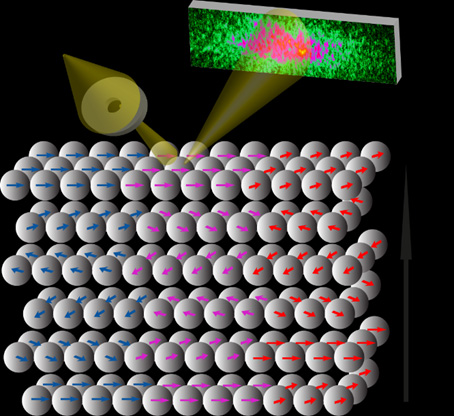Magnetic Systems Mimic Granular Materials
Magnetic domains exhibit the same dynamic jamming behavior universal to granular materials, polymers, glasses and emulsions.

The Science
Research reveals that the collective behavior of magnetic domains near the magnetic ordering temperature resembles the dynamical behavior of a wide range of materials.
The Impact
It is estimated that 40% of the noise in magnetic read heads and magnetoresistive random access memory (MRAM) devices - the emerging higher density memory technology - is due to magnetic noise. Since magnetic domain fluctuations are the cause of noise in a magnetic system, understanding the behavior of magnetic domain fluctuations will enable reduction in the noise levels in such nanodevices.
Summary
Similar to what happens to vehicles in traffic jams, in systems with particle density above a threshold value, a jamming transition occurs wherein the motion of particles is restricted and also correlated by the motion of the surrounding ones. This type of jamming behavior is universal to a variety of systems such as granular materials, polymers, concentrated emulsions and glasses. What this research reveals is that even magnetic domains – the volume of ordered electron spins found in magnetic materials - behave very much like other granular material systems, and their dynamical behavior mimics the universal characteristics of several jammed systems. The size and the dynamics of magnetic domains were investigated by using a technique called “resonant magnetic x-ray photon correlation spectroscopy” that uses coherent x-ray beams (similar to laser light) whose energy is tuned to resonantly interact with atomic magnetic moments. As the scattered x-ray beams interact with the material, the interference between the scattered waves from the domain boundaries produce a pattern of “speckles” – spots with fluctuating intensity a function of time – centered on the diffraction spots. These intensity fluctuations are due to the slow movement of the magnetic domain walls and hence the speckle pattern movie - captured on a fast charged coupled detector (CCD) - contains the information on the size and the dynamics of the magnetic domains. Just above the Neel temperature (the temperature at which the spins order in their spiral arrangement) many such clusters with different spin directions exist and grow in size, eventually coalescing into magnetic domains. At the Neel temperature, these domains are head-to-head with each other in a jammed state and the domain boundaries form a disordered network. As the temperature is further lowered - a few degrees below the Neel temperature - the domains grow in size and the dynamics progressively get arrested, as happens in all glassy materials. Understanding the quantitative behavior of magnetic domain fluctuations near phase transitions will enable the control of the noise levels and help to improve the performance of future magnetic nanodevices.
Contact
Sunil Sinha Physics
Dept., University of California, San Diego
ssinha@physics.ucsd.edu
Funding
DOE Office of Science, Basic Energy Sciences program, including support of the Advanced Light Source user facility for the x-ray scattering research.
Publications
S.-W. Chen, H. Guo, K. A. Seu, K. Dumesnil, S. Roy, and S. K. Sinha, “Jamming Behavior of Domains in a Spiral Antiferromagnetic System”, Physical Review Letters, 110, 217201 (2013).
Highlight Categories
Performer: University , SC User Facilities , BES User Facilities , ALS



